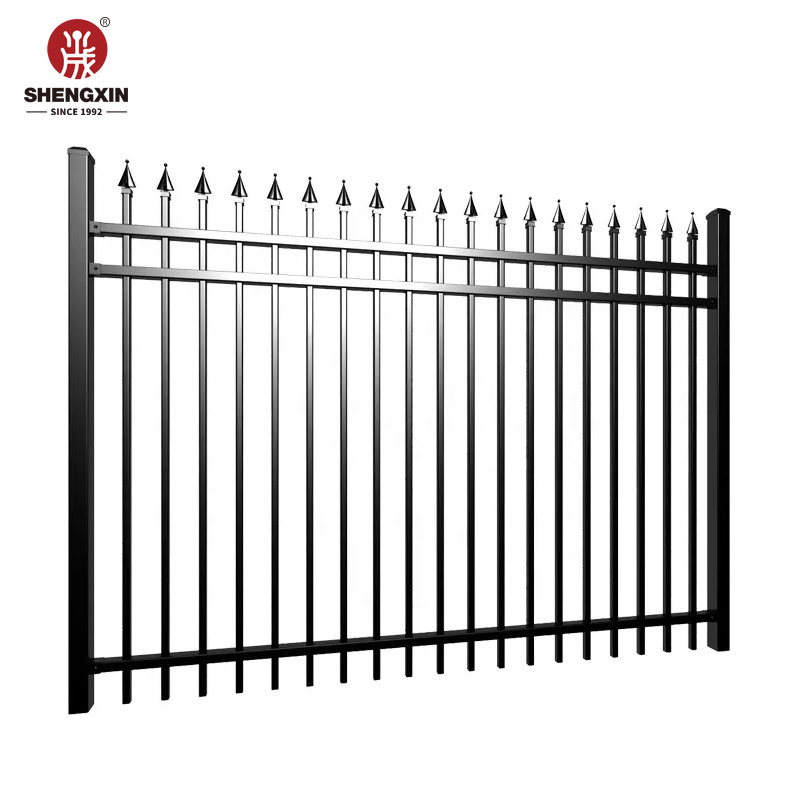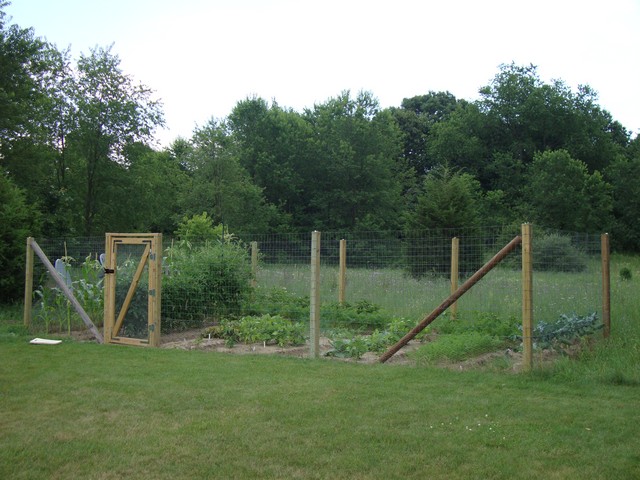
When we decided to put in a vegetable garden, we realized a proper fence with a good gate was essential. As you can see, our property is surrounded by a lot of woods, and we have wild life to show for it. Approximately 90% of all the trees we have planted, whether apple trees, dogwood, flowering pear, or maple trees have been destroyed by deer and rabbits, despite much effort to prevent it. Naturally, we figured: if these animals love trees, they will surely love our vegetables! So a fence was never a question, it was a necessity. In this post, using lots of pictures to explain, I will describe how my husband built our fence; I assisted a little here and there, but he did all the planning and building. He didn’t have any pre-made plans to help him, he just thought about what might make sense and went from there.
Several years later, it is still going strong and in very good shape. And to think, all I wanted was some wire to go around and some way of getting in and out of my garden, and this is what he built me! According to himself, my husband is a technical kinda guy, not a handy-man. And while he is excellent at anything technical, I beg to differ. Just look at that nice work! More beautiful than I ever hoped for, and highly functional! Thank you, sweetheart!!!
Since my fence went up, I’ve grown all kind of vegetables and the experience has been very interesting and fun! Along the way I’ve written some tutorials; a lot of people have found the tomato series and potato series especially helpful as they show step by step in pictures and words just what to do when planting from seed and beyond.
Building the Fence
To build the fence around my vegetable garden, my husband started out putting in 8-foot posts, 4×4 inches or so around. He put one in each corner first, and I believe he tied some string between the posts to place the other ones in straight lines. Two of the posts were placed close together to serve as gate posts. He placed them a distance apart that would allow me to wheel my wheelbarrow through it after the gate was put in.
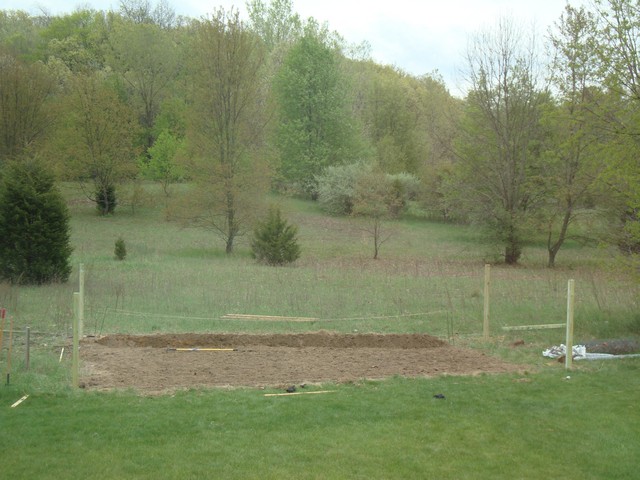
He first dug holes with a regular shovel, then used this nifty post hole digger tool to help him get deeper down without much effort. He put the poles 2 1/2 feet down into the ground. Some people use cement. We didn’t, and it has still held up very well.
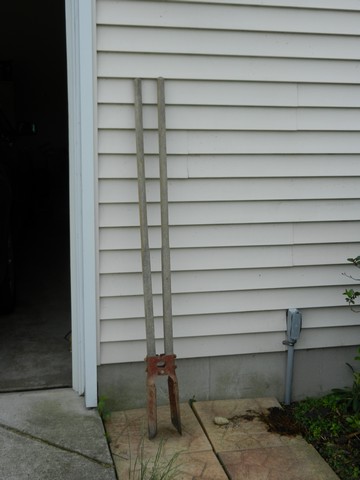
You push this tool down into the dirt, and when you pull the handle apart, it closes around the dirt and you just need to lift it up, out of the hole. Then you repeat until the hole is as deep as you want it.
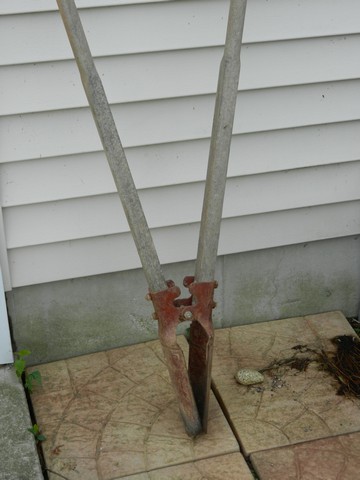
He put in the posts, filled with dirt, packed it down as much as he could by stomping it down and using a shovel to press into it to pack it as much as possible. Then he waited a day or so for the dirt to settle, though more time might have helped it settle more. We didn’t have much time as the season was well under way and I needed to get things planted. So the next day, we put the fencing wire up.
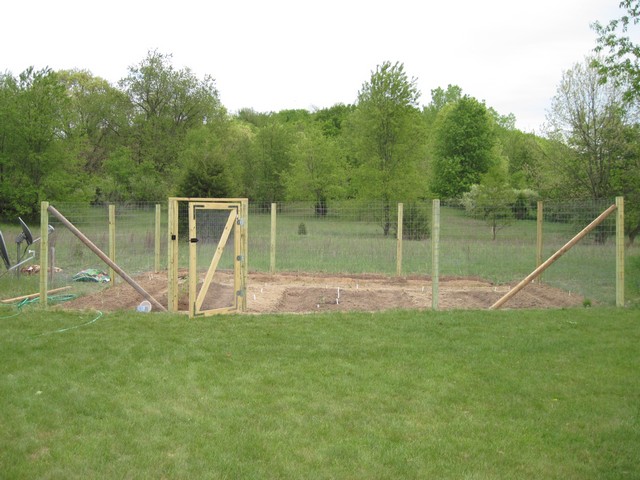
Below is a picture of the fencing wire we put up as the main part of the fence. This wire fencing, as seen in this link, is 4 feet tall, though we added chicken wire as well, with a total fencing height of 5 feet 5 inches. Later on we added electric fencing in addition. (Looking at the link, unless they’ve edited it by now, you’ll see that Home Depot gave an incorrect height measurements, as you can also see in a comment from one of their customers. It is 4 feet tall, not 39 inches.)
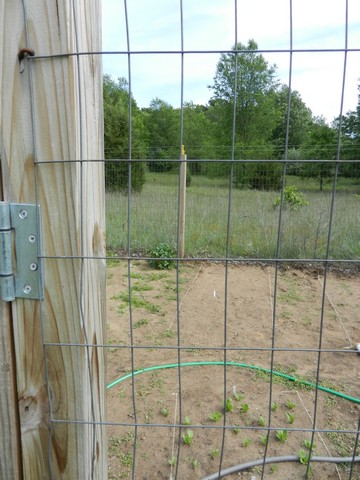
I thought he really found a good way to fasten it, with as little effort as possible. He nailed in some short nails with large, flat heads, but didn’t hammer them all the way in. This allowed him to hook the fencing onto the nails, which held it in place until it was wrapped around the whole area, then he hammered them in a bit more to hold the fencing in place. Both of us pulled the fencing to the next post, hooked it onto the nail in that post, then stretched it to the next post, and so we went until we got it all the way around.
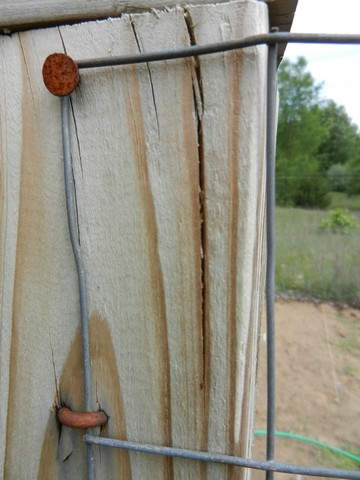
Further down on each post, as seen at the bottom left of the picture above, he nailed in galvanized fence staples, sort of like double nails or V-shaped, that can be hammered in to hold something in place:
So the advantage is that you can hold wiring in place, like in these pictures. He also used more of the large-flat-head nails to fasten, hammering the heads onto the wire to hold it in place. In the following pictures you only see the ends of the V-shaped staples.
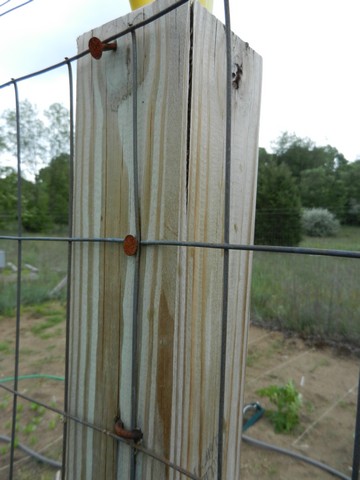
He used these same materials on the corner posts. The yellow thingy you see on the top of the post in the following picture is for electric fencing, which we ended up having to add later on, due to raccoons getting into our corn. I will briefly describe that below.
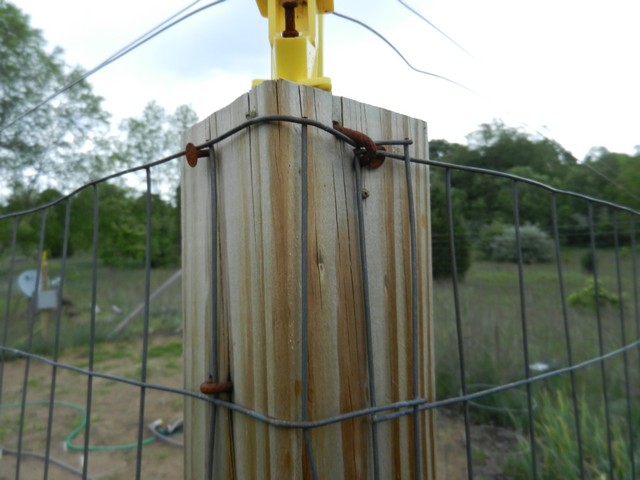
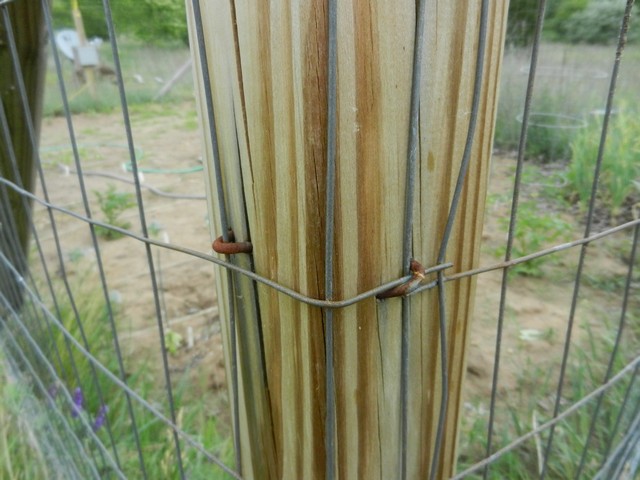
The fencing material we used was for the most part the type you see in the pictures above, though we also decided to add chicken wire, also called chicken netting, on the bottom two feet or so to prevent smaller critters from getting into the garden. There would be far to many temptations and munchies in there to keep all the rabbits out, so chicken wire was also necessary. Since bunnies can, and often will dig underneath fences, we put approximately 17 inches of this netting on the bottom of the fence, so from the ground up to meet the other fencing. Then we wrapped the rest of it out onto the lawn, like a curtain that hangs on the floor and draped out to rest on the floor. So half went out onto the lawn, and half went up to form the bottom of the fence. This way, the bunnies would meet more fencing if they tried to dig, and so far they have not been smart enough to go further out onto the lawn to dig themselves through. I didn’t take pictures of it back then, as I hadn’t started my blog yet and didn’t realize I might someday want to show pictures of it to someone! At this point it is buried under the grass that grew through it and can’t even be seen anymore.
We fastened the chicken netting to the fencing above it with the wire that came with the chicken netting when we purchased it. The netting came in a roll, and was held together with some type of steel wire. So we just took it off when we unrolled it and clipped it into pieces of a few inches long to fasten the fencing materials together.
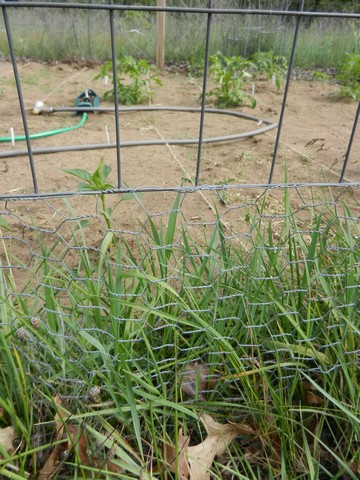
The next picture is taken from the inside of the garden; we may have weeds in our garden, but not a lawn! We fastened the wire around the fencing like this: (We just wound it around here and there.)
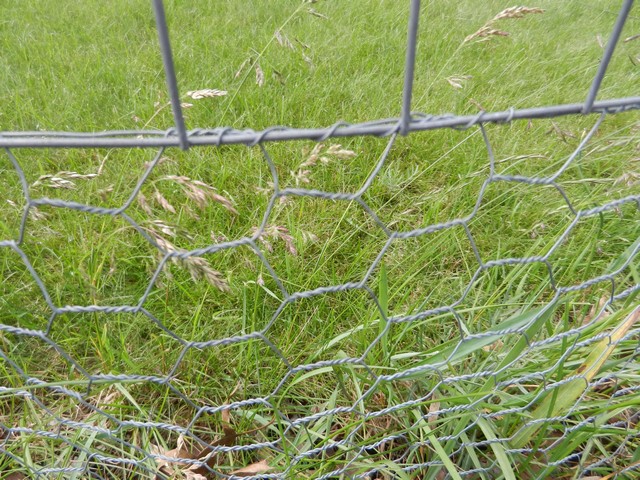
We fasten it in areas of about 8 inches or so apart, about like this for my hands:
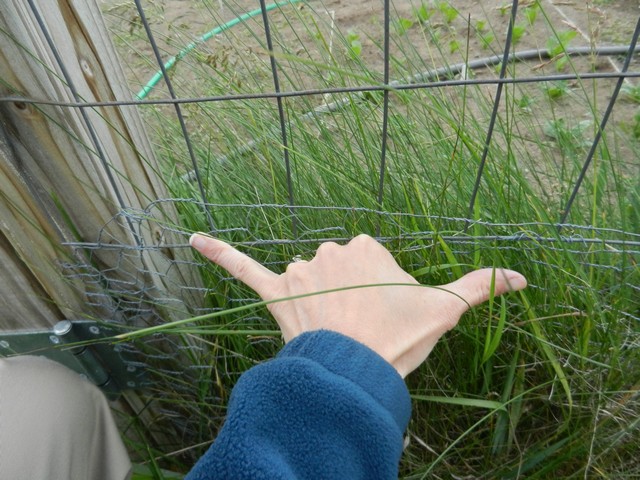
And on the posts, we used these staples, and more galvanized fence staples and nails here and there.
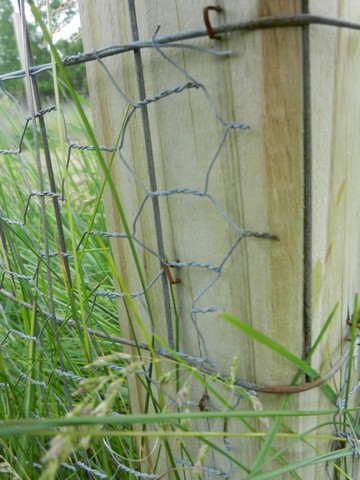
Then my husband made the beautiful, very useful gate. This too, he just put it together based on the size he wanted, and measured and cut the boards accordingly, to fit together. There is a board on the very top and bottom, that helps stabilize and hold it all together. Tall people do have to stoop to get through, but it makes for a solid gate. I am short enough to be able to walk right through it, so it suits me perfectly. The boards we used were a 4×4 post on either side, then 2×4 boards for the rest. The gate ended up being a little bit too narrow to fit properly between the posts, so he put in another 2×4 alongside the 4×4, to make that part a little wider. You can see it on the left side of the gate.
Galvanized Steel Fence With Spear Top
The height of the opening, and the posts on either side of the gate, is 5 ft. 6 in., with the door itself slightly shorter to fit between the top and bottom boards. The opening is slightly wider than one yard.
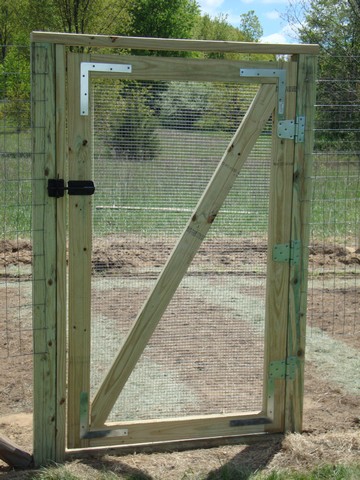
These angled brackets were purchased at Home Depot, along with other materials as well. They were fastened onto each corner, on both sides of the door.
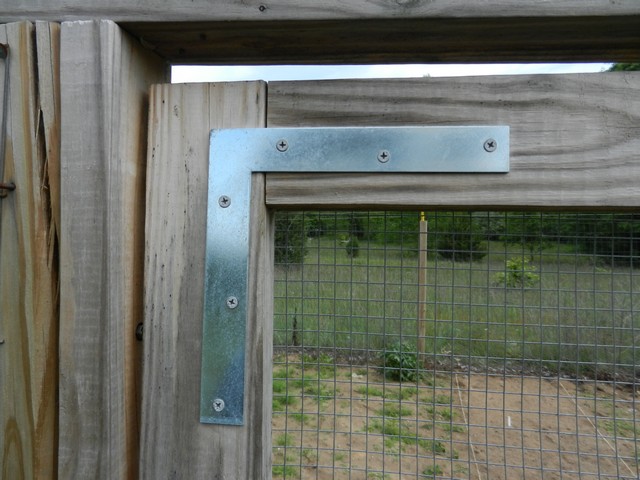
These hinges are approximately 4 1/4 inches tall, to give you an idea of the size.

Another board was put into the door diagonally, to stabilize it, and prevent accidents that might push in the netting. Long screws were put in to fasten this board.
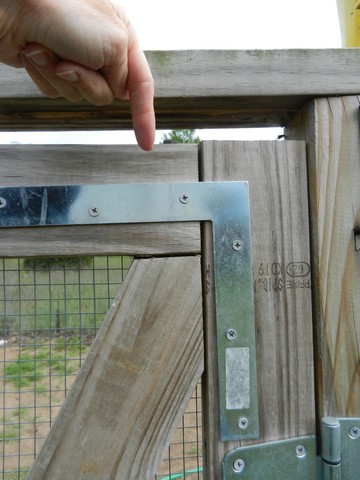
This is the screw.
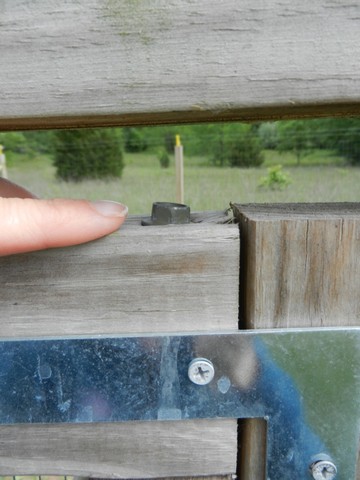
This is a very nice gate latch, it works well to keep the gate closed and is easy to open as well.
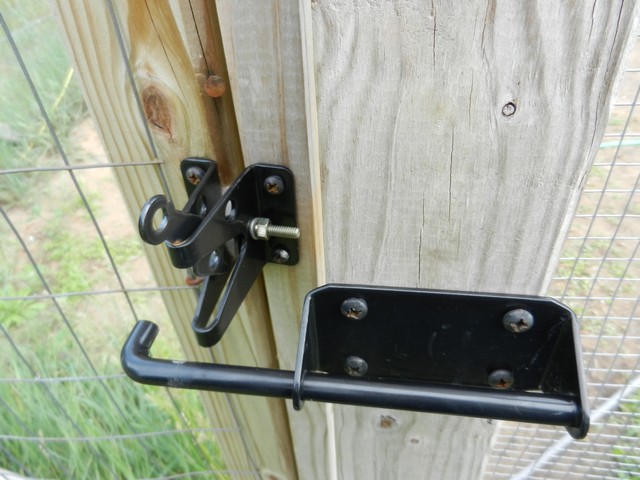
The only thing about it is that the screw that went through the little “latch-thingy” when you open it, fell out or rusted, or somehow broke off. So my husband put in a different screw instead, so it now works like a charm again. I tend to think we have to go buy a new one when something breaks, but he always seems to find a way to fix things. I am so blessed to have him! This one from Amazon seems to be the same kind we have, although there are several other ones to choose from as well.
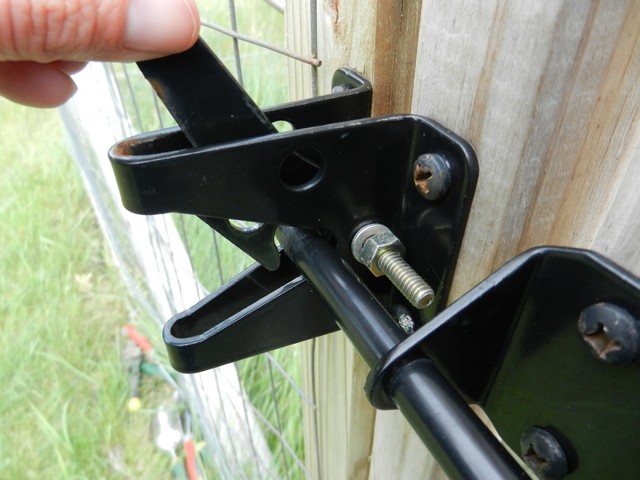
Fortunately, my hands are small enough to fit through the fencing, which is a good thing since it happens frequently that the wind causes the gate to close on me while I’m inside the garden! I’m not going to want to attempt to climb this fence, so I’m glad I’m able to sneak my hand through the fence to open it again, from the inside. See, it happened again just as I was inside today to take some pictures for you! Although one of my readers commented below that the hole in the latch release is designed to let you fasten a cord to it, then with a weight fastened to the cord, you can throw it over to the other side of the gate to give you a way to open it from the inside. Just pull the cord and it opens. Haha, I do have a few things yet to learn! I love it when my readers share helpful information like that!
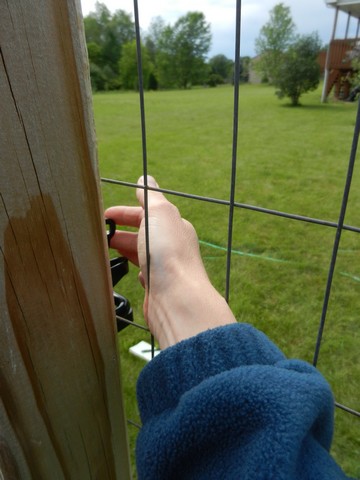
Then we put up a different type of wire, or netting, onto the gate. This netting is quite stiff and strong. Here’s a comparison of the size of the holes to my hand:
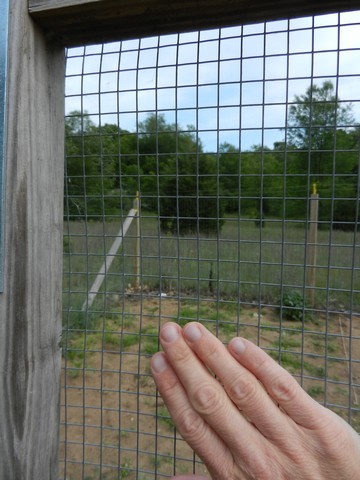
My husband fastened this netting to the inside, using the same method as above:
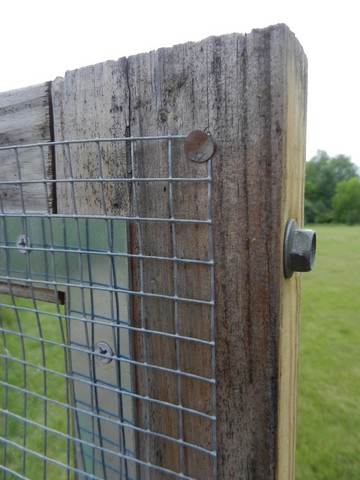
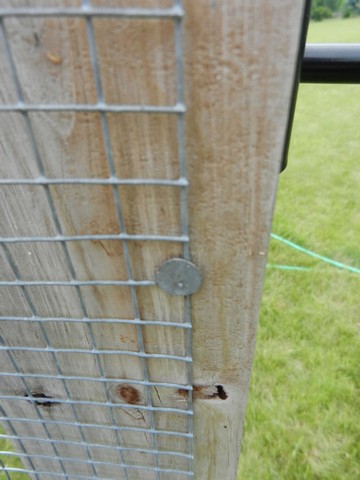
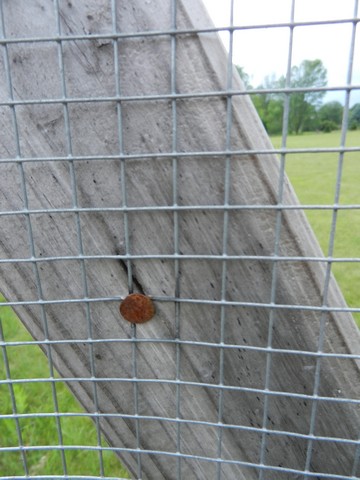
After it all had been put together and the posts began to settle more, we saw that the posts started leaning toward each other. We figured they leaned because of the tightness of the fencing, so my husband ended up putting in more posts, this time forcing them between the poles diagonally to push and keep them apart and standing straight. This might not have happened had we had the time to wait for a week or so to allow the poles to settle, or if we had put them into concrete. It really is hard to say if more time for settling would have made a difference, but these angled posts fixed the problem.
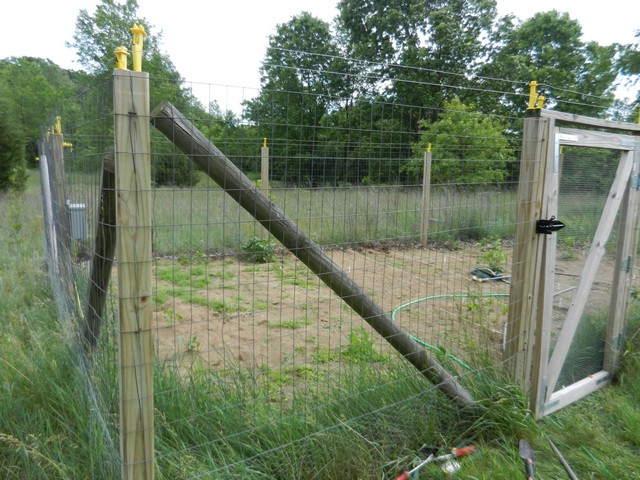
Like I mentioned, we ended up having to put up electric fencing on top of the fence, to keep out raccoons. Before this el. fence was put up, they came into my garden and destroyed most of my corn crop, despite attempts such as spraying with strong pepper solutions, to keep them out. After the electric fence was put up, we never had any more trouble with them.
These yellow brackets are insulators that does the job of holding the wire, as well as serves as insulators to keep the electricity where it’s supposed to be. Having it fastened directly to the wood would have shorted it, plus maybe giving people a little surprise now and again. These insulators were found in the same area of the store as where the wire was located. My husband decided to use aluminum wire rather than steel, as aluminum is light weight and easier to work with, and won’t rust. One wire might do the trick, but two works better as it’s harder for critters to climb over them.
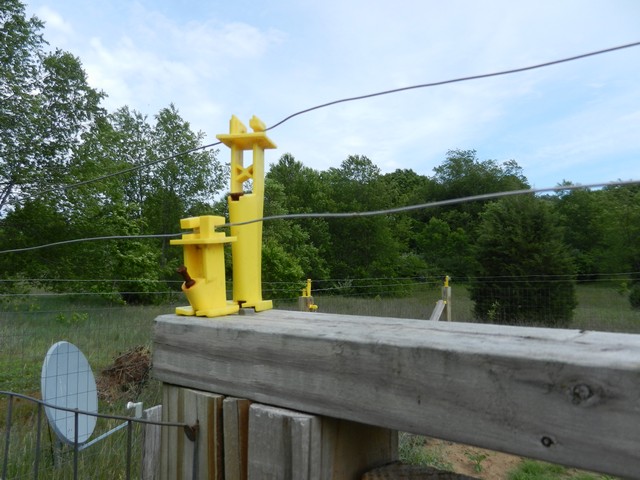
A utility box might not be necessary, but my husband wanted to put one up to protect the electric fencing controller.
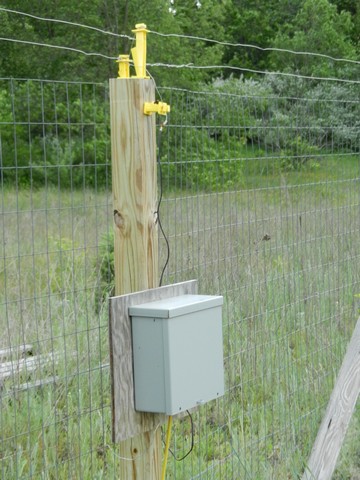
This is the finished fence before the electric part was added:
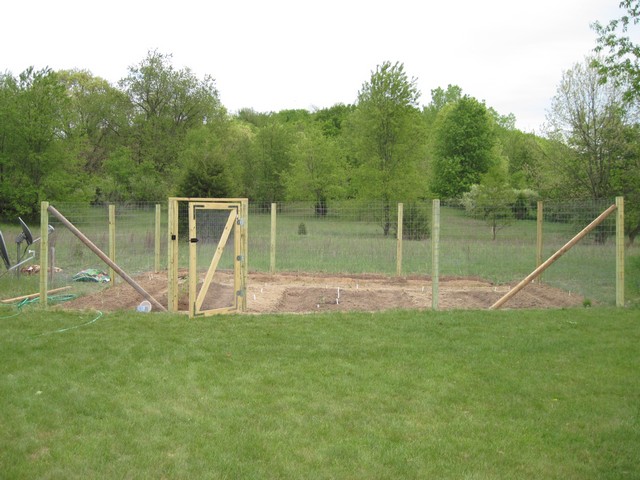
This vegetable garden fence has been so useful for us throughout the years, and to think my husband build it by himself quite easily, without any kind of purchased how-to guide! I hope this information and the pictures are helpful to the rest of you so you can figure out how to make a fence and gate that will work for your needs. I just love having the opportunity to plant and grow wonderful, healthful food right in my own yard! I hope you’ll enjoy your garden as well!



